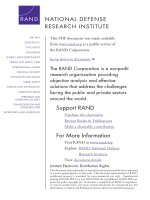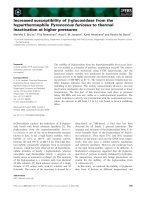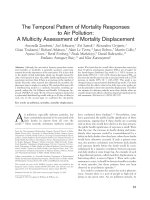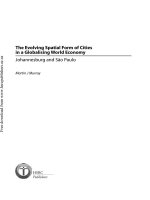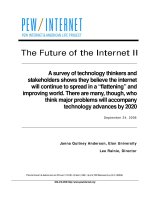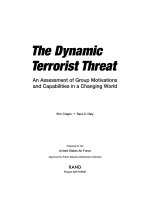The Evolving Terrorist Threat to Southeast Asia - A Net Assessment pptx
Bạn đang xem bản rút gọn của tài liệu. Xem và tải ngay bản đầy đủ của tài liệu tại đây (1.64 MB, 266 trang )
This document and trademark(s) contained herein are protected by law as indicated
in a notice appearing later in this work. This electronic representation of RAND
intellectual property is provided for non-commercial use only. Unauthorized
posting of RAND PDFs to a non-RAND Web site is prohibited. RAND PDFs are
protected under copyright law. Permission is required from RAND to reproduce,
or reuse in another form, any of our research documents for commercial use. For
information on reprint and linking permissions, please see RAND Permissions.
Limited Electronic Distribution Rights
Visit RAND at www.rand.org
Explore RAND National Defense
Research Institute
View document details
For More Information
This PDF document was made available
from www.rand.org as a public service of
the RAND Corporation.
6
Jump down to document
THE ARTS
CHILD POLICY
CIVIL JUSTICE
EDUCATION
ENERGY AND ENVIRONMENT
HEALTH AND HEALTH CARE
INTERNATIONAL AFFAIRS
NATIONAL SECURITY
POPULATION AND AGING
PUBLIC SAFETY
SCIENCE AND TECHNOLOGY
SUBSTANCE ABUSE
TERRORISM AND
HOMELAND SECURITY
TRANSPORTATION AND
INFRASTRUCTURE
WORKFORCE AND WORKPLACE
The RAND Corporation is a nonprofit
research organization providing
objective analysis and effective
solutions that address the challenges
facing the public and private sectors
around the world.
Purchase this document
Browse Books & Publications
Make a charitable contribution
Support RAND
This product is part of the RAND Corporation monograph series.
RAND monographs present major research findings that address the
challenges facing the public and private sectors. All RAND mono-
graphs undergo rigorous peer review to ensure high standards for
research quality and objectivity.
Peter Chalk, Angel Rabasa, William Rosenau, Leanne Piggott
Prepared for The Office of the Secretary of Defense
Approved for public release; distribution unlimited
NATIONAL DEFENSE RESEARCH INSTITUTE
The Evolving
Terrorist Threat to
Southeast Asia
A Net Assessment
The RAND Corporation is a nonprofit research organization providing
objective analysis and effective solutions that address the challenges
facing the public and private sectors around the world. R AND’s
publications do not necessarily reflect the opinions of its research clients
and sponsors.
R
®
is a registered trademark.
© Copyright 2009 RAND Corporation
All rights reserved. No part of this book may be reproduced in any
form by any electronic or mechanical means (including photocopying,
recording, or information storage and retrieval) without permission in
writing from RAND.
Published 2009 by the RAND Corporation
1776 Main Street, P.O. Box 2138, Santa Monica, CA 90407-2138
1200 South Hayes Street, Arlington, VA 22202-5050
4570 Fifth Avenue, Suite 600, Pittsburgh, PA 15213-2665
RAND URL:
To order RAND documents or to obtain additional information, contact
Distribution Services: Telephone: (310) 451-7002;
Fax: (310) 451-6915; Email:
The research described in this report was prepared for the Office of the
Secretary of Defense (OSD). The research was conducted in the RAND
National Defense Research Institute, a federally funded research and
development center sponsored by the OSD, the Joint Staff, the Unified
Combatant Commands, the Department of the Navy, the Marine
Corps, the defense agencies, and the defense Intelligence Community
under Contract W74V8H-06-C-0002.
Library of Congress Cataloging-in-Publication Data is available for this publication.
ISBN 978-0-8330-4658-1
iii
Preface
is monograph, prepared by the RAND Corporation and the Centre
for International Security Studies in Australia, develops a net assess-
ment against which to gauge the scope and parameters of the terrorist
threat to Southeast Asia and, by extension, U.S. security interests in the
region. Its main purpose is to enhance understanding of the dangers
posed by politically motivated violence in Southeast Asia and to rec-
ommend improvements to U.S. counterterrorism (CT) policy, which,
if implemented, would reduce the terrorist threat to the stability of this
important region.
Building on prior RAND research undertaken to analyze the
underlying motives, drivers, and capabilities of the principal extrem-
ist groups that have resorted to terrorist violence in the Philippines,
southern ailand, and across the Indonesian archipelago, this study
examined the historical roots of militancy in these regions to provide
context for assessing the degree to which local agendas are being either
subsumed within a broader ideological framework or shaped by other
extremist movements. To illuminate some of these connections, this
monograph analyzes the organizational structure, cohesion, and ideol-
ogy of Jemaah Islamiyah (JI), the most dangerous of the various dis-
parate jihadist groups operating in this part of the world, and assesses
its capacity to exploit and aggravate established Islamist conflicts in
Southeast Asia. It also includes a dedicated appendix that breaks new
ground in exploring the potential for Cambodia to emerge as an attack
or logistical hub for terrorists over the next five years.
iv The Evolving Terrorist Threat to Southeast Asia: A Net Assessment
By definition, a comprehensive terrorism assessment must include
more than just a threat evaluation. Any meaningful analysis needs
to take into account the thoroughness and relevance of government
countermeasures and capabilities. Accordingly, this monograph exam-
ines the effectiveness of the key national security strategies that have
been enacted by the three regional states that are presently most affected
by terrorism—ailand, the Philippines, and Indonesia—as well as the
impact of U.S. CT and law enforcement assistance that has been pro-
vided to each of these countries.
e subsequent gap analysis should help to provide a comprehen-
sive picture of the overall terrorist environment in Southeast Asia and
the specific nature of the militant support networks currently operating
in this part of the world. It is hoped that these findings will assist the
United States and regional partner-nation governments to better shape
and refine the parameters of their respective assistance programs and
mitigation efforts.
is research was sponsored by the Australian Federal Police and
the Office of the Secretary of Defense and conducted within the Inter-
national Security and Defense Policy Center of the RAND National
Defense Research Institute, a federally funded research and develop-
ment center sponsored by the Office of the Secretary of Defense, the
Joint Staff, the Unified Combatant Commands, the Department of
the Navy, the Marine Corps, the defense agencies, and the defense
Intelligence Community. Comments are welcome and may be directed
to the principal investigator, Peter Chalk, at
For more information on RAND’s International Security and
Defense Policy Center, contact the Director, James Dobbins. He can
be reached by email at ; by phone at 703-
413-1100, extension 5134; or by mail at the RAND Corporation, 1200
S. Hayes Street, Arlington, VA 22202. More information about RAND
is available at www.rand.org.
v
Contents
Preface iii
Figures
ix
Tables
xi
Summary
xiii
Acknowledgments
xix
Abbreviations
xxi
CHAPTER ONE
Introduction 1
CHAPTER TWO
Malay Muslim Extremism in Southern ailand 5
Militant Context
5
Background to the Southern ai Conflict
5
e Malay Muslim Militant Struggle
7
1960–1998
7
1998 –2004
10
2004–Present
12
Militant Groupings
17
Structure and Size
17
Goals and Motivational Drivers
19
Patterns of Recruitment and Radicalization
23
Traction Among the Local Population
25
External Dimensions
26
Assessment
29
vi The Evolving Terrorist Threat to Southeast Asia: A Net Assessment
CHAPTER THREE
Muslim and Communist Extremism in the Philippines 33
Militant Context
33
Militant Groupings
37
Moro Islamic Liberation Front
37
Misuari Breakaway Group
46
Abu Sayyaf Group
49
Communist Party of the Philippines–New People’s Army
57
Assessment
63
CHAPTER FOUR
Terrorism and National Security in Indonesia 67
Militant Context
67
Militant Groupings—Nationalist Islamists
69
Laskar Jihad
69
Front Pembela Islam
71
Antistatist Islamists
75
Laskar Jundullah, KOMPAK Movement, AMIN, and Ring Banten
75
Attitude of Local Population
78
Nascent Jihadist Networks
80
Hizb ut-Tahrir Indonesia
80
Assessment
83
CHAPTER FIVE
e Regional Dimension: Jemaah Islamiyah 87
Background
87
Objectives
89
Structure and Size
92
Operational Activities
96
Participation in Communal Violence in Maluku and Sulawesi
96
Early Terrorist Activity: 2000–2001
97
Terrorist Activity: 2002–2005
98
JI Traction in Southeast Asia
100
JI’s Future Prospects
102
Contents vii
CHAPTER SIX
Counterterrorism and National Security in ailand 105
Historical and Political Context
105
Security Resources Deployed to the South
107
Key Counterterrorism Measures in the South
111
e aksin Administration
111
e Post–September 2006 Situation
115
Peace-Building and Reconciliation
116
Security
118
Dialogue
120
Assessment
122
CHAPTER SEVEN
Counterterrorism and National Security in the Philippines 131
Historical and Political Context
131
Resources Allocated to Internal Security
134
Key COIN and Counterterrorism Measures
137
Assessment
141
CHAPTER EIGHT
Counterterrorism and National Security in Indonesia 149
Historical and Political Context
149
Resources Allocated to the National Security Mission
152
Key Counterterrorism Programs and Measures
157
Assessment
160
CHAPTER NINE
National Security in Southeast Asia: e U.S. Dimension 167
Main Components of U.S. Security and Counterterrorism Assistance
167
International Military Education and Training Program
168
Foreign Military Financing Program
168
Antiterrorism Assistance Program
168
International Narcotics Control and Law Enforcement Program
169
International Criminal Investigative Training Assistance Program
169
Economic Support Fund
170
U.S. Security Assistance to Primary Partner Nations in
Southeast Asia
170
viii The Evolving Terrorist Threat to Southeast Asia: A Net Assessment
ailand 170
Indonesia
172
e Philippines
175
Challenges Associated with the Implementation of U.S. Security
Assistance in Southeast Asia
179
CHAPTER TEN
Conclusion 185
e Current Terrorist Environment in Southeast Asia
185
Policy Recommendations
188
APPENDIX
Exploring the Potential for Emergent Operational and Logistical
Terrorist Hubs in Cambodia
199
Bibliography
215
ix
Figures
2.1. Violent Incidents in Southern ailand,
January 2004–April 2008
13
2.2. Deaths and Injuries, by Religion,
January 2004–April 2008
14
2.3. Leaflet Portraying the ai State as a Rapacious,
Anti-Islamic Entity
17
xi
Tables
3.1. MILF Base Commands 41
5.1. High-Profile JI Neutralizations, 2001–2008
94
5.2. High-Profile Attacks Attributed to JI, 2002–2005
99
9.1. ATA Allocations to Indonesia, FYs 2002–2007
173
9.2. ATA Allocations to the Philippines, FYs 2002–2007
178
10.1. Southeast Asian Ratification of International
Conventions and Protocols on Terrorism
192
10.2. Popular Access to Media and Broadcasting Outlets in
Indonesia, the Philippines, and ailand
197
xiii
Summary
The Current Terrorist Threat
Overall, the terrorist threat to the countries covered in this mono-
graph remains a serious but largely manageable security problem. In
ailand, while the scale and scope of Islamist-inspired violence in the
three southern Malay provinces of Yala, Pattani, and Narathiwat have
become more acute since 2004, the conflict has (thus far) not spread
to the country’s majority non-Muslim population nor has it taken on
an anti-Western dimension.
1
Indeed, at the time of this writing, out-
side demagogues and radicals had singularly failed to gain any con-
certed logistical or ideological foothold in the region, which suggests
that ailand’s so-called “deep south” is unlikely to become a new
hub for furthering the transregional designs of fundamentalist jihadi
elements.
In the Philippines, Moro Muslim extremism has declined mark-
edly since its high point in the 1990s and early 2000s. e Abu Sayyaf
Group (ASG) and Misuari Breakaway Group (MBG) both remain
factionalized with the bulk of their existing cadres mostly confined
to isolated pockets across the Sulu archipelago. e leadership and
1
In this monograph, Islamist is used when describing Islam as a religiopolitical phenom-
enon. e term is an immediate derivation of Islamism, which has its moorings in significant
events of the 20th century, such as the Iranian Revolution, the Soviet invasion of Afghani-
stan, and the Palestinian uprising against Israeli occupation. It is distinguished from Islamic,
which is more correctly understood as signifying religion and culture as it has developed
over the past millennium of Islam’s history. For more on these terminological nuances, see
Denoeux, 2002; Roy, 1994; and 9/11 Commission Report, 2004, p. 562, fn. 3.
xiv The Evolving Terrorist Threat to Southeast Asia: A Net Assessment
mainstream membership of the largest and best-equipped Moro rebel
group, the Moro Islamic Liberation Front (MILF), appears sincere in
its stated desire to reach a comprehensive peace settlement, despite the
breakdown of a cease-fire reached in July 2003. Although a perceptible
communist threat continues to exist, the New People’s Army (NPA)
has witnessed a steady decline in numbers and weapons. Moreover, the
NPA’s ability to fully control those areas that it has infiltrated, which
presently amount to only 5 percent of the country’s total, is declining.
e situation in Indonesia is somewhat more fluid. On the one
hand, the latent threat posed by Islamist radicalism has patently
declined since 2000, reflecting both more effective CT actions on the
part of the police and widespread popular opposition to militant groups
whose attacks have disproportionately affected Muslim interests. On
the other hand, a significant minority of the Indonesian population
harbors a desire for some form of fundamentalist Islamic political order,
which under certain circumstances could spark a resurgence of support
for extremist jihadism if not carefully managed and countered.
e threat environment in Indonesia also has direct relevance for
transnational terrorism in Southeast Asia, not least because the coun-
try plays host to JI. Although the network has been substantially weak-
ened by the arrests of several leading midlevel commanders, as well as
internal disputes over the utility of large-scale, indiscriminate bomb-
ings, it has demonstrated a proven capacity to adapt and will probably
never be fully expunged as a movement of radical ideas.
Counterterrorism Responses
A true assessment of the current terrorist environment in Southeast
Asia must take into account the nature and appropriateness of state
responses. Again, there is reason for guarded optimism here. In ai-
land, the government has gradually come to appreciate the virtues of
more nuanced, dialogue-based approaches to conflict mitigation in
the southern border provinces. e new emphasis on development and
“soft” hearts-and-minds initiatives is likely to continue regardless of
the political complexion of future ai governments.
Summary xv
In the Philippines, the armed forces have made significant prog-
ress in defense reform and civil-military relations and are now reaping
significant rewards in the ongoing battle against Islamist and Moro
extremists in Mindanao. e admittedly halting negotiations with
MILF have made progress, and, with the notable exception of ances-
tral domain, most outstanding issues have now been settled. Manila
has also made headway against the NPA insurgency through a com-
bination of “hard” and “soft” security policies aimed at normalizing
(former) hostile communist areas.
Finally, in Indonesia, the central government has fully committed
to professionalizing the police force and ensuring that it is internation-
ally recognized as adept and accountable. In addition, Jakarta is slowly
augmenting what hitherto have been very weak coastal surveillance
capabilities, and it now recognizes the need for a concerted deradical-
ization program. Most significantly, the government has established
a credible and effective CT unit—Special Detachment [Detasmen
Khusus] 88—which reports directly to the military and has been cred-
ited with the neutralization of at least 450 militants since 2005.
Policy Recommendations
While U.S. security assistance to Southeast Asia has been important to
the development of a more efficacious regional CT strategy and struc-
ture, much more could be done to inoculate this part of the world
against the possibility of a renewed terrorist threat, from either domes-
tic extremists or an emboldened transborder jihadist network. Accord-
ingly, this monograph offers the following recommendations.
Better integrate CT, law and order, and development policies to
address the issue of corruption in the region. is enduring and pervasive
problem not only fuels resentment against incumbent governments,
it also sustains popular support for extremist groups. It is crucially
important that elected officials, bureaucrats, and other representatives
of the state are able to win the trust and confidence of their own com-
munities and thereby deny terrorists the political influence they need
to grow their support and mount effective operations.
xvi The Evolving Terrorist Threat to Southeast Asia: A Net Assessment
Promote further police reform in the Philippines and ailand. is
could certainly be done through the current bilateral suite of assistance
that is provided through the U.S. Department of State (DoS) Anti-
terrorism Assistance (ATA) program, International Narcotics Control
and Law Enforcement (INCLE) program, and International Crimi-
nal Investigative Training Assistance Program (ICITAP). However, the
United States should additionally consider sponsoring a much broader
program of professional training through nascent but proven multi-
lateral arrangements. Entities such as the Jakarta Centre for Law
Enforcement Cooperation (JCLEC), the Southeast Asia Regional
Centre for Counter-Terrorism (SEARCCT), and the International Law
Enforcement Academy (ILEA) in Bangkok all offer the major advan-
tage of bringing practitioners together in a single organizational setting
where professional networks can be built and ideas and perspectives on
terrorism and CT can be exchanged and debated.
Foster a less benign environment for terrorism in Southeast Asia by
increasing support for regional institutions, such as the Association of
Southeast Asian Nations (ASEAN), the ASEAN Regional Forum, Asia-
Pacific Economic Cooperation, and the East Asia Summit. Channel-
ing security and CT assistance through these collaborative frameworks
will help reduce the perception that terrorism is an exclusively Ameri-
can problem. It will also provide an opportunity to buttress indigenous
capabilities in areas where Washington is unable to operate bilaterally
for political or logistical reasons.
Press all 10 ASEAN countries to sign and ratify each of the 16 United
Nations (UN) conventions dealing with CT. Although political agree-
ment was reached at the Jakarta Sub-Regional Ministerial Meeting in
March 2007 on the need to strengthen legal CT tools, the fact remains
that many Southeast Asian countries have yet to enact a broad range of
conventions and protocols relating to terrorism.
Emphasize the use of soft power to enhance local governance in regions
susceptible to fundamentalist propaganda (through INCLE); foster greater
military and police awareness of human rights and appropriate rules of
engagement (through U.S. Department of Defense–sponsored Interna-
tional Military Education Training program, or IMET, courses); and
promote general socioeconomic development (through the U.S. Agency
Summary xvii
for International Development [USAID] and DoS Economic Support
Fund, or ESF). To ensure that these types of endeavors have a long-
term, sustainable impact, it is critical that they be carried out in close
cooperation with national and local authorities and are executed with
due regard for community consultation in civic action planning.
Supplement the use of soft power with “smart” power. is can
be achieved by (1) spearheading public diplomacy, exchange, and
educational efforts to discredit perverted interpretations of Islam;
(2) empowering moderate Muslim leaders as voices for greater reli-
gious negotiation; (3) investigating possible alternatives for reducing
the pull of pan-regional sentiment from the inside out, by ascertain-
ing the extent to which emergent fissures between JI’s mainstream and
the pro-bombing faction can be exploited; and (4) promoting prison
reform to reduce the potential for jails to be exploited as recruiting
or radicalization hubs. ese dialogue and communication initiatives
should focus not only on Southeast Asian states with established mili-
tant Islamic entities but also on countries that could foster or other-
wise encourage hardline Islamist sentiment. Notable in this regard is
Malaysia, where a more radical, “enabling” environment could emerge
if divisions within the Malay community widen as a result of domestic
political instability.
Give greater attention to identifying and supporting conventional
and nonconventional broadcasting and message-delivery systems that can
be effectively utilized in a multilayered communication strategy aimed
at countering the proselytizing activities of extremist groups. Properly
employed, these conduits could be highly effective in prosecuting the
“struggle of ideas”—not least by targeting and influencing those sec-
tors that are most able to bolster the middle ground of political com-
promise and, through this, foster an environment that is hostile (or at
least nonreceptive) to the appeal of violent Islam.
xix
Acknowledgments
e authors would like to express their gratitude to those interviewed
for this project, the names of whom have been deliberately withheld
due to the sensitive nature of the topic at hand. In addition, a special
expression of thanks is owed to Paul Smith of the Naval War College
in Newport, Rhode Island, and to RAND colleague Kim Cragin for
their insightful reviews of the document. Additional acknowledgments
are owed to Lauren Skrabala for editing the manuscript and to James
Dobbins and Alan Dupont for their feedback on earlier versions of
this monograph. Needless to say, all errors and oversights are the sole
responsibility of the authors.
xxi
Abbreviations
ABRI Angkatan Bersenjata Republik Indonesia
AFP Armed Forces of the Philippines
AKKBB Aliansi Kebangsaan untuk Kebebasan Beragama
dan Berkeyakinan
AMIN Angkatan Mujahidin Islam Nusantara
ANFO ammonium nitrate–fuel oil
ARMM Autonomous Region of Muslim Mindanao
ASG Abu Sayyaf Group
ASEAN Association of Southeast Asian Nations
ATA Antiterrorism Assistance program
BAKIN Baden Koordinasi Intelijen Negara
BIAF Bangsamoro Islamic Armed Forces
BIN Baden Intelijen Nasional
BNPP Barisan Nasional Pembebasan Patani
BRIMOB Brigade Mobil
BRN Barisan Revolusi Nasionale
BRN-K Barisan Revolusi Nasional–Koordinasi
xxii The Evolving Terrorist Threat to Southeast Asia: A Net Assessment
CMO civil-military operation
CNS Council for National Security
COIN counterinsurgency
CPM Civilian-Police-Military Task Force
CPP Communist Party of the Philippines
CT counterterrorism
DI Darul Islam
DoD U.S. Department of Defense
DoJ U.S. Department of Justice
DoS U.S. Department of State
ESF Economic Support Fund
FBI Federal Bureau of Investigation
FMF Foreign Military Financing program
FK AW J Forum Komunikasi Ahlus Sunnah wal Jama’ah
FPI Front Pembela Islam
GAM Gerakan Aceh Merdeka
GMIP Gerakan Mujahidin Islam Patani
GRP government of the Republic of the Philippines
GWOT global war on terrorism
HRW Human Rights Watch
HTI Hizb ut-Tahrir Indonesia
HuT Hizb ut-Tahrir
ICG International Crisis Group
Abbreviations xxiii
ICITAP International Criminal Investigative Training
Assistance Program
IED improvised explosive device
ILEA International Law Enforcement Academy
ILPS International League of People’s Struggle
INCLE International Narcotics Control and Law
Enforcement program
IMET International Military Education and Training
program
ISOC Internal Security Operations Command
JCLEC Jakarta Centre for Law Enforcement Cooperation
JI Jemaah Islamiyah
JUSMAG-P Joint U.S. Military Assistance Group–Philippines
KLI Komando Laskar Islam
KM Komite Aksi Penanggulangan Akibat Krisis
Mujahidin
KOMPAK Komite Aksi Penanggulangan Akibat Krisis
LJ Laskar Jihad
LM Laskar Mujahidin
LPSA Local Peace and Security Assembly
MBG Misuari Breakaway Group
MILF Moro Islamic Liberation Front
MoA-AD memorandum of agreement on ancestral domain
MNLF Moro National Liberation Front
MoU memorandum of understanding

